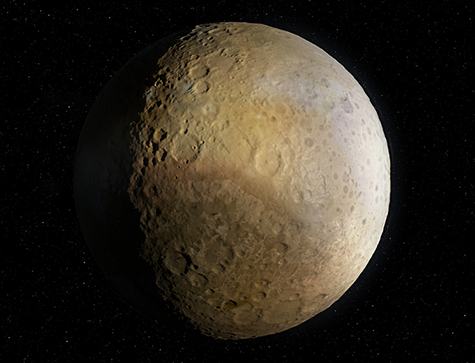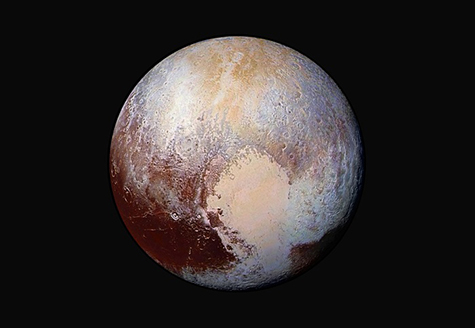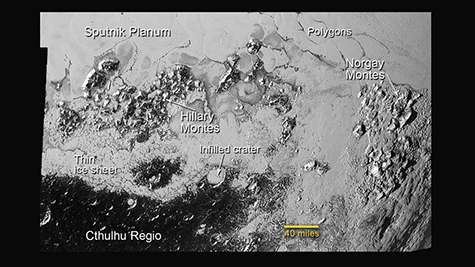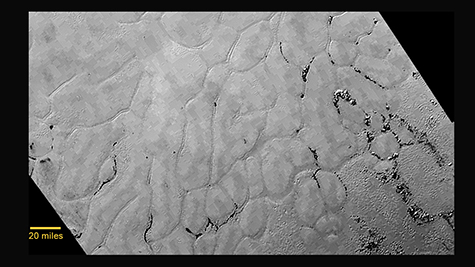
On June 3, 2015, more than a month before New Horizons, flying faster than speeding bullet, reached its rendezvous with the Pluto system, an astronomer at the Southwest Research Institute who is also a space artist posted a “final guess” at what the planet might look like.
Bill McKinnon, PhD, a planetary scientist at Washington University in St. Louis, who is deputy lead scientist with the New Horizons geology and geophysics team, said of the guess, “Personally, I will be disappointed if we see so many craters.”
Why disappointed? Because craters are the scars of old impacts, and if a planet’s face is heavily scarred, it means there is no active geological process to renew and sculpture the planet’s surface. Many craters would mean Pluto was dead and, like most dead things, boring.

So when the first clear images came down from the spacecraft after the flyby, there was jubilation in Maryland, home to the Applied Physics Laboratory of the Johns Hopkins University that had built the New Horizons spacecraft and is managing the mission.
“This is unbelievable,” a scientist who spoke for all present was heard to say.
Not only were there few craters, but some areas of the planet were as smooth as a billiard ball and others rumpled and rippled; some stained the color of dried blood and others gleaming bright white. The variety meant that there was geology on Pluto, alien though the geological processes might be to earthlings.
Only a few images of the planet have been posted so far (95 percent of the data is still aboard the space craft) but those are all Pluto fans will see until the end of September. Then, as the principal investigator Alan Stern said in a July 24 news briefing, “the spigot opens again and images will rain down from the sky.” (Well, maybe drizzle; the downlink has a bandwidth of just a few kilobits per second, about the speed of an old modem connection to the Internet.)

Scant as the “browse set” of images may be, it still contains enough surprises and puzzles to entertain the mission scientists for at least the next two months.
First of all, why is Pluto red? Scientists think it is colored by particles called tholins, or star-tar, created in the atmosphere when methane interacts with the sun’s ultraviolet light to form a mixture of complex hydrocarbons. As the haze particles clump and grow heavier, they fall out of the atmosphere and coat the planet’s surface.
Carl Sagan first called attention to tholins in the 1970s when he tried to create chemistry in his laboratory that might explain the red in the Great Red Spot of Jupiter, but they’re also found elsewhere in the solar system, most notably on Saturn’s moon Titan, where there might be dune fields of tholins.
But the tholins are interesting primarily because they reveal disturbed ground, such as Pluto’s famous heart, informally called Tombaugh Regio (a large area of a planet named after Clyde Tombaugh, Pluto’s discoverer).
As Michael Summers, a member of the atmosphere science team, pointed out at the press briefing, the two lobes of the heart are not the same. The bright material in the right lobe is thinner and looks as though it had drifted or blown over from the thicker left lobe.
When it was Bill McKinnon’s turn to speak, he put up a slide of the left lobe of the heart, where the flat icy plain the scientists named Sputnik Planum adjoins more rugged terrain.

“If you look carefully at the image of the northern edge of Sputnik Planum, you can see a pattern that indicates ice is flowing to the scarp or cliff boundary of the rugged terrain,” McKinnon said. “The streamlines, which I’ve marked with curved arrows, look just like glacial flow on the Earth.
“To the northwest the ice seems to be flowing around barrier islands and to the north,” he said, “you can see ice flowing through a breach in an old impact crater and partially filling the crater.
“Water ice at Pluto’s temperatures [380 degrees below zero Fahrenheit] is immobile and brittle; it’s not moving anywhere. But the nitrogen ice, carbon monoxide ice and methane ice that make up the Planum are geologically soft and malleable under Pluto conditions, and will flow in the same way that glaciers do on Earth.

McKinnon then turned to an image from the south edge of Sputnik Planum where ice has surrounded and embayed the mountain range named Hillary Montes, extending all the way around it and feathering the edge of the dark Cthulhu Regio. (Hillary Montes is named after Sir Edmund Hillary who together with the Sherpa Tenzing Norgay first climbed Mount Everest and Cthulu is a god of the underworld invented by horror writer H.P. Lovecraft.)
“In the south you can see a crater, about the size of the D.C. Metro area, that has become a pond of nitrogen ice,” he said.” If you look carefully, he said, you see that the structure of the ice between the Montes and the Cthulhu Regio is quite different and finer than that on the Planum, which means the ice at the border is substantially thinner.”
The scientists on the panel spoke carefully, sticking to description for the most part, and avoiding explanations where they could. But the reporters at the briefing pushed for more.
Eric Hand with Science Magazine asked McKinnon, “Could I ask you to speculate maybe about what could be driving these flows and embayments, and also how this source region got there to begin with. There have been debates whether this is ices that accumulated from above, layers of frost turning into glaciers over time, or something allowing ices to well up from within. Can you explain how this intruding spot right in the belly of the planet got to be there, and then what’s driving it?”
One of the problems with Pluto is that its atmosphere is like Strega Nona’s magical pasta pot, continually escaping to space and yet continually renewed. Before the flyby, McKinnon had said, “There is either a really thick layer of ice that hasn’t yet been depleted, or a source of continuous supply,” he said. “And that’s something we’ll actually get to the bottom of when we get there, because there will either be thick ice caps that would take billions of years to erode or just a thin glaze of ices that must be replenished from somewhere.”
Now, McKinnon told Hand, we’ve found the reservoir. “We have a region, a vast region, that seems to be truly a reservoir, the supply depot for the entire environment.” He went on to say that the heart might be an ancient impact basin and that it could have been filled from below. “Imagine,” he said, “that inside the icy crust of Pluto there is liquid nitrogen in cracks and spaces, liquid because it is always warmer inside a planet than at its surface. This reservoir of liquid nitrogen could actually supply the planet.”

This hypothesis might also explain one of the stranger features of the Planum, the polygonal shapes in the otherwise smooth ice. “Our leading model for their formation is that there is internal convection; the nitrogen ice slowly rises in the centers of the polygons as it warms and sinks along their boundaries as it cools. As long as the ice is a least a half a mile deep, we think that process can operate.”
Anyone who has contemplated miso soup cooling or oatmeal boiling has seen the roiling polygons of convection cells, also powered by heat from the bottom.
But, McKinnon quickly added, “we can’t fully explain what’s going on because we’ve only seen these seven images. The internal reservoir of heat is an interesting idea, but it’s early days yet and we’re still enjoying a great deal of animated discussion.”
Pluto is so small it should have lost much of the heat released by its formation and by radioactive isotopes in its interior. And since it is far from larger bodies that might tug it to-and-fro, it cannot be warmed by tidal heating. So McKinnon still has some explaining to do, but given his track record so far, it would be unwise to bet against him.